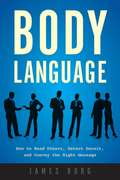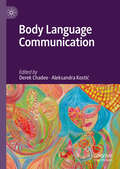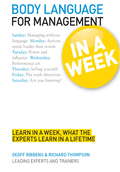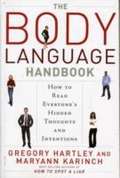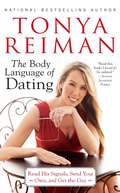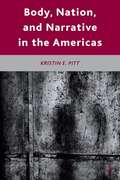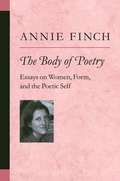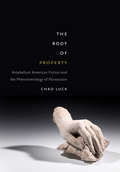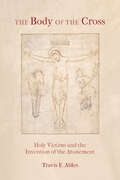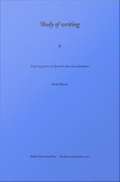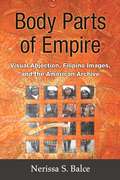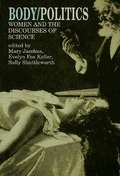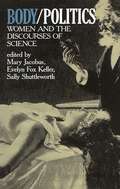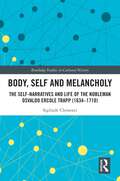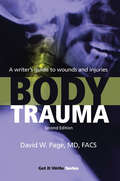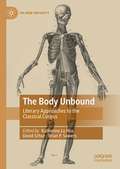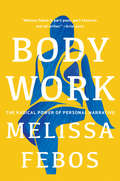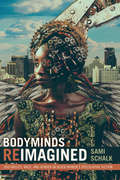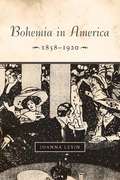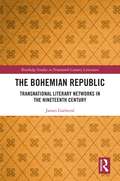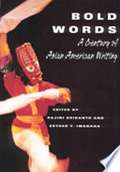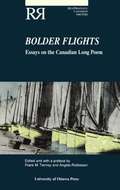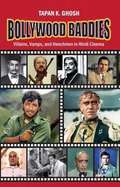- Table View
- List View
Body Language: How to Read Others, Detect Deceit, and Convey the Right Message
by James BorgBody language is a vital part of everyday communication, but more often than not, we are unaware of the messages our bodies are sending to others. Body Language will teach you to become more aware of these issues. In seven lessons, you will not only learn to read others, but also learn to control your own posture to send the correct message to those around you. This guide will help you: Make a good first impression Match your words to your body posture Read facial expressions, and decipher meaning from the eyes and tone of voice Understand what certain postures, such as folded arms and crossed legs, mean Quickly discern if someone is lying
Body Language Communication
by Derek Chadee Aleksandra KostićThis book explores a number of important themes within body language discourse. The authors analyse the role of hands, touch, facial expression, misconceptions, and fallacious arguments in body language training. Other issues addressed include body language between humans and machines, lie detection, reactance and body language and thermography of the face. The authors work to determine various potentials of body language, and assess some areas of body language and role of body language in everyday life. They also discuss new perspectives and future directions in body language studies.
Body Language for Management in a Week: Teach Yourself (Teach Yourself In A Week Ser.)
by Richard Thompson Geoff RibbensThe ability to read people's body language and send out the right signals yourself, is crucial to anyone who wants to advance their career.Written by Geoff Ribbens and Richard Thompson, leading experts on body language, this book quickly teaches you the insider secrets you need to know to in order give a successful appraisal.The highly motivational 'in a week' structure of the book provides seven straightforward chapters explaining the key points, and at the end there are optional questions to ensure you have taken it all in. There are also cartoons and diagrams throughout, to help make this book a more enjoyable and effective learning experience.So what are you waiting for? Let this book put you on the fast track to success!
Body Language for Management in a Week: Teach Yourself (Teach Yourself In A Week Ser.)
by Geoff Ribbens Richard ThompsonThe ability to read people's body language and send out the right signals yourself, is crucial to anyone who wants to advance their career.Written by Geoff Ribbens and Richard Thompson, leading experts on body language, this book quickly teaches you the insider secrets you need to know to in order give a successful appraisal.The highly motivational 'in a week' structure of the book provides seven straightforward chapters explaining the key points, and at the end there are optional questions to ensure you have taken it all in. There are also cartoons and diagrams throughout, to help make this book a more enjoyable and effective learning experience.So what are you waiting for? Let this book put you on the fast track to success!
The Body Language Handbook: How to Read Everyone's Hidden Thoughts and Intentions
by Gregory Hartley Maryann KarinchIn "The Body Language Handbook", the authors use candid photos of real people in stress-free situations, then juxtapose them against others showing the same people responding to different kinds of stimulus to illustrate the power of body language. By going step-by-step from the holistic to the detailed, you'll quickly discover when body language indicates something significant, and when an itch is just an itch.
The Body Language of Dating: Read His Signals, Send Your Own, and Get the Guy
by Tonya ReimanPrimal instinct meets the power of choice in this go-to guide to getting the guy. The last time you locked eyes with a gorgeous, manly specimen across the room or took a detour past the object of your affection, fluffing your locks on your way to the powder room, you probably didn't think you were performing an ancient mating dance. Whether the fashion of the day is miniskirts or mammoth hides, the knowing glances, chest puffing, hair tossing, and backside brandishing are all part of a complicated ritual choreographed over epochs and designed for your very survival. Thankfully, evolution has taken care of the hard part, leaving today's woman with the sometimes daunting task of deciphering the intriguing, often infuriating signals of modern man. In this smart, funny, and invaluable book, nationally renowned body language expert Tonya Reiman decodes the complicated dating game. While some of us seem to have been born with a razor-sharp "sexual instinct," the rest of us could use a little practice. Luckily, the formula for dating success is easy to learn. Within these pages, you'll discover how to display the body language necessary for making solid connections with potential mates, uncover the mysteries of man himself, and find handy new tricks for your attraction arsenal. Not only that, The Body Language of Dating will teach you how to: Whether you feel like you couldn't attract a fireman with your head ablaze or just want to give your seasoned connection-rejection ratio a boost, Tonya Reiman will help you shave time, effort, and heartbreak from your mating quest. She didn't make the rules, but she sure can teach you how to use them. * Read a guy's facial expressions, gestures, and posture for clues to his state of mind. * Tell long-term mates from short-term dates. (Hint: You can often tell just by looking at him!) * Send silent messages that tug on your hottie's heartstrings. * Save yourself from losers like Not-Interested Nate and Stalker Steve and get straight to Mr. Right (or Mr. Right Now). * Wield the science of scent in any social situation. Whether you feel like you couldn't attract a fireman with your head ablaze or just want to give your seasoned connection-rejection ratio a boost, Tonya Reiman will help you shave time, effort, and heartbreak from your mating quest. She didn't make the rules, but she sure can teach you how to use them.
Body, Nation, and Narrative in the Americas
by Kristin E. PittThis book contextualizes 21st century representations of disappearance, torture, and detention within a historical framework of inter-American narratives. Examining a range of sources, Pitt finds a persistent focus on the body that links contemporary practices of political terror to concerns about corporality and sovereignty.
The Body of Poetry
by Annie FinchThe Body of Poetry collects essays, reviews, and memoir by Annie Finch, one of the brightest poet-critics of her generation. Finch's germinal work on the art of verse has earned her the admiration of a wide range of poets, from new formalists to hip-hop writers. And her ongoing commitment to women's poetry has brought Finch a substantial following as a "postmodern poetess" whose critical writing embraces the past while establishing bold new traditions. The Body of Poetry includes essays on metrical diversity, poetry and music, the place of women poets in the canon, and on poets Emily Dickinson, Phillis Wheatley, Sara Teasdale, Audre Lorde, Marilyn Hacker, and John Peck, among other topics. In Annie Finch's own words, these essays were all written with one aim: "to build a safe space for my own poetry. . . . [I]n the attempt, they will also have helped to nourish a new kind of American poetics, one that will prove increasingly open to poetry's heart." Poet, translator, and critic Annie Finch is director of the Stonecoast low-residency MFA program at the University of Southern Maine. She is co-editor, with Kathrine Varnes, of An Exaltation of Forms: Contemporary Poets Celebrate the Diversity of Their Art, and author of The Ghost of Meter: Culture and Prosody in American Free Verse, Eve, and Calendars. She is the winner of the eleventh annual Robert Fitzgerald Prosody Award for scholars who have made a lasting contribution to the art and science of versification.
The Body of Property: Antebellum American Fiction and the Phenomenology of Possession
by Chad LuckWhat does it mean to own something? How does a thing become mine? Liberal philosophy since John Locke has championed the salutary effects of private property but has avoided the more difficult questions of property’s ontology. Chad Luck argues that antebellum American literature is obsessed with precisely these questions.Reading slave narratives, gothic romances, city-mystery novels, and a range of other property narratives, Luck unearths a wide-ranging literary effort to understand the nature of ownership, the phenomenology of possession. In these antebellum texts, ownership is not an abstract legal form but a lived relation, a dynamic of embodiment emerging within specific cultural spaces—a disputed frontier, a city agitated by class conflict.Luck challenges accounts that map property practice along a trajectory of abstraction and “virtualization.” The book also reorients recent Americanist work in emotion and affect by detailing a broader phenomenology of ownership, one extending beyond emotion to such sensory experiences as touch, taste, and vision. This productive blend of phenomenology and history uncovers deep-seated anxieties—and enthusiasms—about property across antebellum culture.
The Body of the Cross: Holy Victims and the Invention of the Atonement
by Travis E. AblesThe Body of the Cross is a study of holy victims in Western Christian history and how the uses of their bodies in Christian thought led to the idea of the cross as a substitutionary sacrifice. Since its first centuries, Christianity has traded on the suffering of victims—martyrs, mystics, and heretics—as substitutes for the Christian social body. These victims secured holiness, either by their own sacred power or by their reprobation and rejection. Just as their bodies were mediated in eucharistic, social, and Christological ways, so too did the flesh of Jesus Christ become one of those holy substitutes. But it was only late in Western history that he took on the function of the exemplary victim.In tracing the story of this embodied development, The Body of the Cross gives special attention to popular spirituality, religious dissent, and the writing of women throughout Christian history. It examines the symbol of the cross as it functions in key moments throughout this history, including the parting of the ways of Judaism and Christianity, the gnostic debates, martyr traditions, and medieval affective devotion and heresy. Finally, in a Reformation era haunted by divine wrath, these themes concentrated in the unique concept that Jesus Christ died on the cross to absorb divine punishment for sin: a holy body and a rejected body in one.
Body of Vision
by Michael SindingIn Body of Vision, Michael Sinding connects Northrop Frye's groundbreaking contributions to our understanding of the human imagination with cognitive poetics - the cutting-edge school of literary criticism that applies the principles of cognitive science to the interpretation of literary texts and contexts. Sinding undertakes this task through analyses of the interplay of metaphoric and narrative schemas in several forms of cultural mythology.Sinding identifies the profound connections between cognitive views of language, literature, and culture and Frye's views by exploring three related aspects of Frye's work - meaning and thought, culture and society, and literary history. He investigates these connections through detailed studies of major cultural texts including Dante's Divine Comedy, Hobbes' Leviathan, Rousseau's Social Contract, and Milton's "Lycidas." By linking Frye's classic studies to exciting recent approaches in the humanities and the cognitive revolution of the past few decades, Body of Vision casts Frye's achievements in a fascinating new light.
Body of Writing: Figuring Desire in Spanish American Literature
by René PrietoBody of Writing focuses on the traces that an author's "body" leaves on a work of fiction. Drawing on the work of six important Spanish American writers of the twentieth century, Ren Prieto examines narratives that reflect--in differing yet ultimately complementary ways--the imprint of the author's body, thereby disclosing insights about power, aggression, transgression, and eroticism. Healthy, invalid, lustful, and confined bodies--as portrayed by Julio Cortzar, Guillermo Cabrera Infante, Gabriel Garca Mrquez, Severo Sarduy, Rosario Castellanos, and Tununa Mercado--become evidence for Roland Barthes's contention that works of fiction are "anagrams of the body. " Claiming that an author's intentions can be uncovered by analyzing "the topography of a text," Prieto pays particular attention not to the actions or plots of these writers' fiction but rather to their settings and characterizations. In the belief that bodily traces left on the page reveal the motivating force behind a writer's creative act, he explores such fictional themes as camouflage, deterioration, defilement, entrapment, and subordination. Along the way, Prieto reaches unexpected conclusions regarding topics that include the relationship of the female body to power, male and female transgressive impulses, and the connection between aggression, the idealization of women, and anal eroticism in men. This study of how authors' longings and fears become embodied in literature will interest students and scholars of literary and psychoanalytic criticism, gender studies, and twentieth-century and Latin American literature.
Body Parts of Empire: Visual Abjection, Filipino Images, and the American Archive
by Nerissa BalceBody Parts of Empire is a study of abjection in American visual culture and popular literature from the Philippine-American War (1899-1902). During this period, the American national territory expanded beyond its continental borders to islands in the Pacific and the Caribbean. Simultaneously, new technologies of vision emerged for imagining the human body, including the moving camera, stereoscopes, and more efficient print technologies for mass media. Rather than focusing on canonical American authors who wrote at the time of U.S. imperialism, this book examines abject texts--images of naked savages, corpses, clothed native elites, and uniformed American soldiers--as well as bodies of writing that document the goodwill and violence of American expansion in the Philippine colony. Contributing to the fields of American studies, Asian American studies, and gender studies, the book analyzes the actual archive of the Philippine-American War and how the racialization and sexualization of the Filipino colonial native have always been part of the cultures of America and U.S. imperialism. By focusing on the Filipino native as an abject body of the American imperial imaginary, this study offers a historical materialist optic for reading the cultures of Filipino America.
Body/Politics: Women and the Discourses of Science
by Sally Shuttleworth Mary Jacobus Evelyn Fox KellerBody/Politics demonstrates how many of the controversies in modern science involve or invoke the feminine body as their battleground. This groundbreaking collection addresses such scientific issues as artificial fertilization, the "crisis" in childbirth management,and the medical invention of "female" maladies and the debates surrounding them. In the process it makes an important attempt to remedy the traditional division between science and non-science by focusing on the interconnection of literary, social, and scientific discourses concerning the female body. The editors have brought together noted feminist scholars and critics from various fields. Contributers include Susan Bordo, Mary Ann Doane, Donna Haraway, Emily Martin, Mary Poovey and Paula A. Treichler.
Body Politics: Women, Literature, and the Discourse of Science
by Sally Shuttleworth Evelyn F. Keller Mary JacobusThis groundbreaking collection addresses such scientific issues as artificial fertilization, the "crisis" in childbirth management, the medical invention of "female" maladies, and the debates surrounding them.
Body, Self and Melancholy: The Self-Narratives and Life of the Nobleman Osvaldo Ercole Trapp (1634-1710) (Routledge Studies in Cultural History)
by Siglinde ClementiThis book addresses early modern concepts of the body and the self – focussing on three self-narratives authored by the nobleman Osvaldo Ercole Trapp (1634–1710), a body description from head to foot, autobiographical writings, and a brief chronicle of the House of Trapp-Caldonazzo. Approaching the complex theme of the question of the early modern self and the historical body, this book intertwines consistent contextualisation and historicisation of self-interpretation and biography. This is done in three steps: first, the content and function of these self-narratives are analysed with reference to current research on early modern self-narratives. In a second step, the life and family history of Osvaldo Ercole Trapp are examined from a microhistorical perspective and placed within the context of the early modern history of Tyrol’s nobility. A third step then goes into detail on individual contexts and discourses that refine one’s comprehension of these self-narratives: noble masculinity; family, house and line; theories of procreation and education; body experience and body images. It combines textual analysis, historical anthropology with a strong gender-historical perspective, microhistory and the history of the body as a history of experience and discourse. With this approach, the study makes an innovative contribution to early modern studies on self-narratives, social history of early modern nobility and the history of the body as the history of experience and discourse. This volume will be of interest to students and scholars alike interested in intellectual, social and cultural history.
Body Trauma
by David W. PageBody Trauma explains what happens to body organs and bones maimed by accident or intent and the small window of opportunity for emergency treatment. Research what happens in a hospital operating room and the personnel who initiate treatment. Use these facts to bring added realism to your stories and novels.
The Body Unbound: Literary Approaches to the Classical Corpus (The New Antiquity)
by Katherine Lu Hsu David Schur Brian P. SowersThis book explores the body’s physical limits and the ways in which the confines of the body are delineated, transgressed, or controlled in literary and philosophical texts. Drawing on classics, philosophy, religious studies, medieval studies, and critical theory and examining material ranging from Homer to Game of Thrones, this volume facilitates an interdisciplinary investigation into how the boundaries of the body define the human form in language. This volume’s essays suggest that the body’s meaning is perhaps never more evident than in the violation of its wholeness. The boundaries of the body are areas of transition between states and are therefore vulnerable. As individuals find themselves isolated from their world and one another, their bodies regularly allow for physical interactions, incur transgressions and violations, and undergo profound transformations. Thus sympathy, sexuality, disease, and violence are among the main themes of the volume, which, ultimately, reexamines the place of the body in our understanding of what it means to be human.
Body Work: The Radical Power of Personal Narrative
by Melissa FebosMemoir meets craft masterclass in this “daring, honest, psychologically insightful” exploration of how we think and write about intimate experiences—“a must read for anybody shoving a pen across paper or staring into a screen or a past" (Mary Karr). <p><p> In this bold and exhilarating mix of memoir and master class, Melissa Febos tackles the emotional, psychological, and physical work of writing intimately while offering an utterly fresh examination of the storyteller’s life and the questions which run through it. <p><p> How might we go about capturing on the page the relationships that have formed us? How do we write about our bodies, their desires and traumas? What does it mean for an author’s way of writing, or living, to be dismissed as “navel-gazing”—or else hailed as “so brave, so raw”? And to whom, in the end, do our most intimate stories belong? <p><p> Drawing on her own path from aspiring writer to acclaimed author and writing professor—via addiction and recovery, sex work and academia—Melissa Febos has created a captivating guide to the writing life, and a brilliantly unusual exploration of subjectivity, privacy, and the power of divulgence. Candid and inspiring, Body Work will empower readers and writers alike, offering ideas—and occasional notes of caution—to anyone who has ever hoped to see themselves in a story.
Bodyminds Reimagined: (Dis)ability, Race, and Gender in Black Women's Speculative Fiction
by Sami SchalkIn Bodyminds Reimagined Sami Schalk traces how black women's speculative fiction complicates the understanding of bodyminds—the intertwinement of the mental and the physical—in the context of race, gender, and (dis)ability. Bridging black feminist theory with disability studies, Schalk demonstrates that this genre's political potential lies in the authors' creation of bodyminds that transcend reality's limitations. She reads (dis)ability in neo-slave narratives by Octavia Butler (Kindred) and Phyllis Alesia Perry (Stigmata) not only as representing the literal injuries suffered under slavery, but also as a metaphor for the legacy of racial violence. The fantasy worlds in works by N. K. Jemisin, Shawntelle Madison, and Nalo Hopkinson—where werewolves have obsessive-compulsive-disorder and blind demons can see magic—destabilize social categories and definitions of the human, calling into question the very nature of identity. In these texts, as well as in Butler’s Parable series, able-mindedness and able-bodiedness are socially constructed and upheld through racial and gendered norms. Outlining (dis)ability's centrality to speculative fiction, Schalk shows how these works open new social possibilities while changing conceptualizations of identity and oppression through nonrealist contexts.
Bohemia in America, 1858-1920
by Joanna LevinBohemia in America, 1858-1920explores the construction and emergence of "Bohemia" in American literature and culture. Simultaneously a literary trope, a cultural nexus, and a socio-economic landscape,la vie bohèmetraveled to the United States from the Parisian Latin Quarter in the 1850s. At first the province of small artistic coteries, Bohemia soon inspired a popular vogue, embodied in restaurants, clubs, neighborhoods, novels, poems, and dramatic performances across the country. Levin's study followsla vie bohèmefrom its earliest expressions in the U. S. until its explosion in Greenwich Village in the 1910s. Although Bohemia was everywhere in nineteenth- and twentieth-century American culture, it has received relatively little scholarly attention. Bohemia in America, 1858-1920fills this critical void, discovering and exploring the many textual and geographic spaces in which Bohemia was conjured. Joanna Levin not only provides access to a neglected cultural phenomenon but also to a new and compelling way of charting the development of American literature and culture.
The Bohemian Republic: Transnational Literary Networks in the Nineteenth Century (Routledge Studies in Nineteenth Century Literature)
by James GatheralIn the mid-nineteenth century successive cultural Bohemias were proclaimed in Paris, London, New York, and Melbourne. Focusing on networks and borders as the central modes of analysis, this book charts for the first time Bohemia’s cross-Channel, transatlantic, and trans-Pacific migrations, locating its creative expressions and social practices within a global context of ideas and action. Though the story of Parisian Bohemia has been comprehensively told, much less is known of its Anglophone translations. The Bohemian Republic offers a radical reinterpretation of the phenomenon, as the neglected lives and works of British, Irish, American, and Australian Bohemians are reassessed, the transnational networks of Bohemia are rediscovered, the presence and influence of women in Bohemia is reclaimed, and Bohemia’s relationship with the marketplace is reconsidered. Bohemia emerges as a marginal network which exerted a paradoxically powerful influence on the development of popular culture, in the vanguard of material, social and aesthetic innovations in literature, art, journalism, and theatre. Underpinned by extensive and original archival research, the book repopulates the concept of Bohemianism with layers of the networked voices, expressions, ideas, people, places, and practices that made up its constituent social, imagined, and interpretive communities. The reader is brought closer than ever to the heart of Bohemia, a shadowy world inhabited by the rebels of the mid-nineteenth century.
Bold Words: A Century of Asian American Writing
by Rajini SrikanthA century of Asian American writing has generated a forceful cascade of "bold words." This anthology covers writings by Asian Americans in all genres, from the early twentieth century to the present. Some sixty authors of Chinese, Filipino, Japanese, Korean, South Asian, and Southeast Asian American origin are represented, with an equal split between male and female writers. The collection is divided into four sections-memoir, fiction, poetry, and drama-prefaced by an introductory essay from a well-known practitioner of that genre: Meena Alexander on memoir, Gary Pak on fiction, Eileen Tabios on poetry, and Roberta Uno on drama. The selections depict the complex realities and wide range of experiences of Asians in the United States. They illuminate the writers' creative responses to issues as diverse as resistance, aesthetics, biculturalism, sexuality, gender relations, racism, war, diaspora, and family. Rajini Srikanth teaches at the University of Massachusetts, Boston. She is the coeditor of the award-winning anthology Contours of the Heart: South Asians Map North America and the collection A Part, Yet Apart: South Asians in Asian America. Esther Y. Iwanaga teaches Asian American literature and literature-based writing courses at Wellesley College and the University of Massachusetts, Boston.
Bolder Flights: Essays on the Canadian Long Poem
by Frank M. Tierney Angela RobbesonA growing number of literary historians and critics now recognize the contemporary long poem as a distinctively Canadian genre. This collection of essays leads the reader to a deeper understanding of Canadian literary cultures in terms of their local intimacies and idiosyncrasies as well as in their national contexts.
Bollywood Baddies
by Tapan K GhoshBollywood Baddies is the first-of-its-kind book-length narrative of villainy in Hindi films. It discusses villains, vamps, and henchmen of Bollywood cinema, and also the actors who essayed such characters over the decades. The author discusses not just villains but also the evaluation of villainous characters vis-à-vis sociopolitical conditions in the country. The narrative begins with Ashok Kumar's negative role in Kismet as early as 1943, and goes up to the Agneepath remake (2012), where Sanjay Dutt plays Kancha Cheena, earlier essayed by Danny Denzongpa in the original. In between, it discusses all major villains, from Lala Sukhiram (Mother India) to Gabbar (Sholay) to "Lion" Ajit (Kalicharan) to Mogambo (Mr. India), and many others. While keeping villains in the focus, it also discusses popular henchmen and vamps, like M B Shetty, Sharat Saxena, Nadira, Bindu, Helen, among others, to understand the dimension of the villains' empire. After all, it's our villains who make our protagonist the hero we all admire. An engrossing read, this book is for every film buff.
